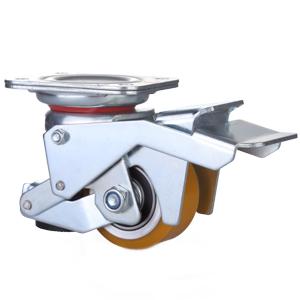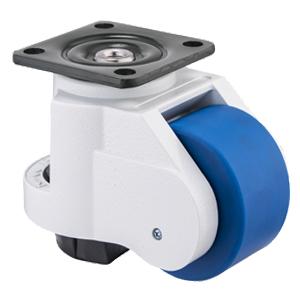Adjustable leveling casters
Adjustable leveling casters are a versatile solution for equipment that requires both mobility and precise leveling. They blend the functionality of traditional casters with the stability of fixed leveling feet, offering enhanced performance in various applications. Here’s a comprehensive overview of adjustable leveling casters:


1. Overview and Functionality
Adjustable leveling casters are designed to offer both mobility and stability. They feature a mechanism that allows the user to adjust the height of the caster, enabling the equipment to be leveled precisely. This adjustment is particularly useful on uneven surfaces or in situations where stability is crucial.
2. Key Components
Caster Wheel: The wheel is typically made from durable materials such as polyurethane, rubber, or nylon. It provides smooth movement and is chosen based on the floor type and load requirements.
Adjustment Mechanism: This mechanism allows the caster to be raised or lowered. It can be a threaded rod, a screw jack, or a pneumatic system, depending on the design.
Mounting Plate or Stem: This part connects the caster to the equipment. It can be a plate with mounting holes or a stem that fits into a socket or bracket.
Locking Mechanism: Many adjustable leveling casters include a locking feature to secure the equipment in place once the desired height is achieved.
3. Types of Adjustable Leveling Casters
Manual Adjustment: These use a screw or threaded rod to adjust the height. They are operated by hand and offer precise control over the level of the equipment.
Pneumatic Adjustment: Some models use a pneumatic system to adjust the height. This can be more convenient and requires less physical effort compared to manual systems.
Electric Adjustment: These use an electric motor to adjust the height. They provide ease of use and precise control but may require a power source.
4. Benefits
Enhanced Stability: Adjustable leveling casters provide a stable base for equipment, reducing the risk of tipping or wobbling. This is particularly important for sensitive or expensive machinery.
Improved Mobility: When adjusted to the correct height, the equipment can be easily moved, offering flexibility in repositioning.
Protection of Floors: By lifting the equipment off the floor, adjustable leveling casters can help prevent damage to flooring surfaces, which is beneficial in both industrial and commercial settings.
Versatility: They are suitable for a wide range of applications, from industrial machinery to office furniture, making them a flexible choice for many environments.


5. Applications
Industrial Equipment: In manufacturing or industrial settings, adjustable leveling casters are used on machinery and workstations to ensure stability on uneven floors.
Laboratories: In lab environments, precise leveling is often required to maintain accurate measurements and prevent spills or accidents.
Commercial Furniture: For office or retail furniture, these casters allow for easy adjustment and mobility while maintaining a stable position.
Medical Equipment: Adjustable leveling casters are used on medical equipment to ensure stability and ease of movement within healthcare facilities.
6. Considerations for Selection
Load Capacity: Ensure the casters can support the weight of the equipment. Load capacity varies among different models and materials.
Floor Type: The wheel material should be chosen based on the type of flooring to avoid damage and ensure smooth movement.
Adjustment Range: Consider the range of height adjustment required for your specific application.
Durability: Choose casters made from high-quality materials to ensure long-lasting performance, especially in demanding environments.
7. Maintenance
Regular maintenance is crucial for the longevity of adjustable leveling casters. This includes:
Cleaning: Keep the wheels and adjustment mechanism clean to prevent debris from affecting performance.
Inspection: Periodically check for wear and tear, ensuring that the adjustment mechanism functions correctly and that the locking feature is secure.
Lubrication: Apply lubrication to the moving parts to maintain smooth operation.
8. Installation and Adjustment
Installing adjustable leveling casters typically involves mounting them to the equipment and adjusting the height as needed. Follow the manufacturer’s instructions for proper installation and adjustment procedures. Ensure the equipment is level before securing it in place.
Adjustable leveling casters are a valuable addition to any setup requiring both mobility and stability. They provide a solution for uneven surfaces and varying load conditions while offering ease of movement and floor protection. By understanding their components, benefits, and considerations, you can make an informed choice for your specific needs, ensuring optimal performance and durability.



 English
English Spanish
Spanish German
German Russian
Russian Arabic
Arabic Portuguese
Portuguese Italian
Italian French
French Hebrew
Hebrew Turkish
Turkish